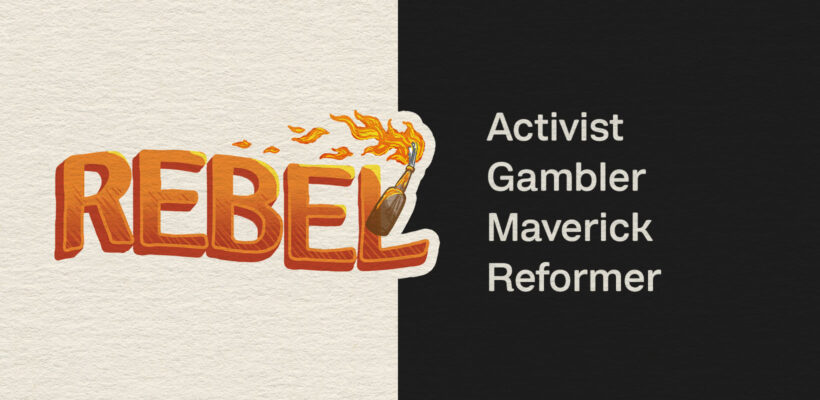
Is the rebel in you bursting out?
Does your business’s personality seem to always go against the grain? Do you (as a company) make the risky choice, going left instead of right? Are you attracted to change itself or to the drama and chaos that surrounds change? So many ways to be, well, rebellious. And that’s why we’re focusing on the Rebel archetypal family this month.
There are five personas that make up the Rebel archetypal family, and while they share many aspects of resistance and are agents of change, they have big differences.
To illustrate, while the Rebel archetype, one of the twelve core archetypes in the full group of sixty, is about taking risks and being provocative, it is truly about gaining power and overturning the established order. What, then, do the other personas represent?
The Other Archetypes in the Rebel Family…
As facets of the Rebel, these archetypes exemplify different types of non-conformists.
The Activist is the champion, the one who works to wake people up and change their behavior.
Think Erin Brockovich or Ben & Jerry’s, the Activist is someone (or some brand) who is willing to take a stand against the opposition in order to make the world a better place. Outgoing, motivating and tireless, this person (or brand) can ignite a revolution.
Obey Clothing as the Activist.
Obey Clothing is a clothing company founded in 2001 by street artist and illustrator Shepard Fairey as an extension to his work in activism.
The brand is known for incorporating politically and socially provocative propaganda into the designs of their clothing. Fairey’s designs deal with such themes as self-empowerment and antiestablishmentarianism. (Say that three times fast.)
He uses the word “obey” sarcastically (ironically?) to describe the way propagandists try to bend the world to their views, and says it’s used to question your purpose and your surroundings. Activism? To the core.
The Gambler thrives on the thrill of risk, and is willing to bet anything (money, emotions, reputation and even the truth) if the stakes are favorable.
Constantly calculating the odds, the Gambler ultimately derives a sense of power and control with every “win.”
DraftKings as the Gambler.
They say it right out front: “At DraftKings, we believe life’s more alive with skin in the game.” There it is in black and white.
The thrill of the risk is the big draw for DraftKings, a daily fantasy sports contest and sports betting company. They live their brand with the heart of the gambler, knowing that highlighting risk-takers and thrill-seekers will appeal to their market who also believe that “life’s a gamble.”
The Maverick is fearless, independent and non-conforming.
(They didn’t name Tom Cruise’s character in Top Gun Maverick for nothing.) Motivated to protect freedom, the Maverick feels that rules were made to be broken, and that it’s easier to ask for forgiveness rather than permission.
Alexander McQueen as the Maverick.
Fashion designer Alexander McQueen was a Maverick from the beginning; his early collections, labeled Nihilism and Highland Rape, relied on shock tactics rather than wearability, a strategy that helped him establish a strong identity.
Absolutely fearless, McQueen’s designs continued to be a highly original blend of subversion and tradition, frequently featuring slashed, stabbed, and torn cloth, as well as McQueen’s brutally sharp style of tailoring. He zigged when others zagged, unapologetically.
The Reformer, unlike some of the other Rebel family members, has more self control and less aggression.
The Reformer works for change by making improvements in the existing system rather than throwing it out and starting new, by reducing disorder rather than inciting it. Very logical and practical, the Reformer believes in rehabilitation, and finds fulfillment in improving…everything.
Spotify as the Reformer.
When streaming radio took off, it was Napster and Pandora that were breaking ground.
But as the Reformer, Spotify made a good thing better, offering a no-cost subscription service with just one catch: Ads. If you didn’t want your music to be interrupted, Spotify offered a premium ad-free service for a monthly membership fee and soon became one of the most popular music streaming services in the world.
True to their Reformer brand, they are constantly working to improve, offering their listeners ways to find “the right music for every moment” and reform their own worlds.
Just how rebellious are you?
We hope you were intrigued by this discussion of the Rebel archetypal family and the important nuances among the personas.
By looking at the specific differences and nuances in archetype groups that seem close in nature, you’re able to really drill down and discover the bone-deep truth of your brand. AND how to use that knowledge to develop crystal-clear messaging.
👉 Dive into archetypes and how to use them to empower your brand.
Ready to explore your brand archetypes and understand how to use them to build your business?
Red Chalk would love to chat! Schedule a consultation and let’s put the power of brand archetypes to work creating a desirable brand.
If you want to explore the world of archetypes and how they are used in brand management, we highly recommend the book Archetypes in Branding: A Toolkit for Creatives and Strategists, written by Margaret Hartwell and Joshua C. Chen.



